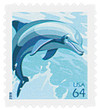
# 4388 - 2009 64c Dolphin
Dolphin
Issue Date: June 12, 2009
City: Washington, DC
Click-click-click... In tropical ocean waters, bottlenosed dolphins hunt their prey using echolocation, which is similar to a ship’s sonar. Bottlenosed dolphins make up to 1,000 clicking noises per second, which travel underwater until reaching an object. The sound is then bounced back to the dolphins, relaying the prey’s location, size, and shape.
In groups known as pods, 15 up to over 100 dolphins work together to hunt and capture schools of fish. Dolphins communicate through a series of squeaks, whistles, and body language, which includes jumping out of the water and slapping their tails on the waves. When one dolphin is in distress, the rest of the pod will often help it to the surface. Dolphins usually swim to the surface to breathe through their blowholes two or three times a minute, but they can remain underwater for nearly 20 minutes.
Research now suggests dolphins possess a high level of intelligence. In one study, a dolphin was shown some cards with varying numbers of dots in different sizes and positions, and correctly touched the card with the larger number of dots. Generally curious toward humans, dolphins have been known to help injured divers find their way to the surface.
Dolphin
Issue Date: June 12, 2009
City: Washington, DC
Click-click-click... In tropical ocean waters, bottlenosed dolphins hunt their prey using echolocation, which is similar to a ship’s sonar. Bottlenosed dolphins make up to 1,000 clicking noises per second, which travel underwater until reaching an object. The sound is then bounced back to the dolphins, relaying the prey’s location, size, and shape.
In groups known as pods, 15 up to over 100 dolphins work together to hunt and capture schools of fish. Dolphins communicate through a series of squeaks, whistles, and body language, which includes jumping out of the water and slapping their tails on the waves. When one dolphin is in distress, the rest of the pod will often help it to the surface. Dolphins usually swim to the surface to breathe through their blowholes two or three times a minute, but they can remain underwater for nearly 20 minutes.
Research now suggests dolphins possess a high level of intelligence. In one study, a dolphin was shown some cards with varying numbers of dots in different sizes and positions, and correctly touched the card with the larger number of dots. Generally curious toward humans, dolphins have been known to help injured divers find their way to the surface.













